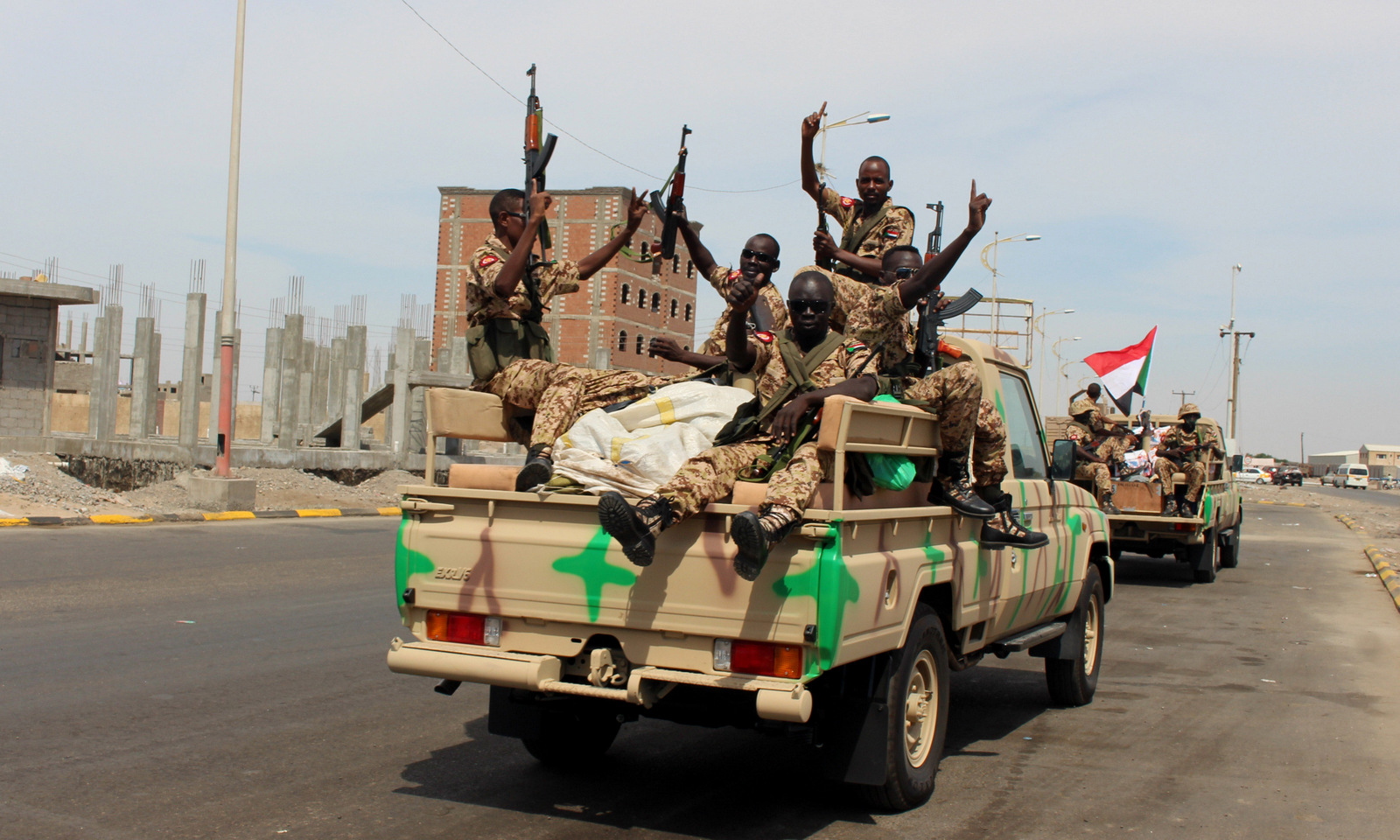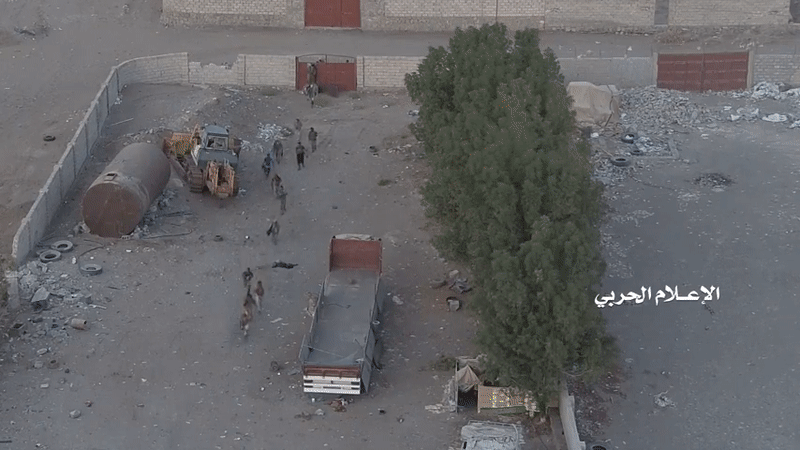HODEIDA, YEMEN — Following twelve days of clashes in Yemen’s strategic port city of Hodeida, the Yemeni Army, supported by local volunteer fighters as well as Ansar Allah (Houthi), has pushed back a large-scale offensive by Saudi Arabia, its coalition allies and the mercenary fighters it employs. The attack is the latest of multiple failed attempts by the coalition to seize and occupy Hodeida, considered the most important stronghold of Yemen’s resistance and home of the port responsible for supplying the country with up to 70 percent of its much-needed food imports.
Fierce battles for control of the city are ongoing and have centered on Hodeida’s southern and eastern outskirts. Mercenaries — supported by heavy coalition airstrikes — have managed to capture the Yemen Company for Flour Mills and Silos (YCFMS) and the Ekhwan Thabit Company, located to the southeast of the city’s main entrance. The noise of Apache helicopters, artillery and gunfire continue to echo through the city’s streets without pause.
In the first days of the attack, the coalition managed to overwhelm local fighters on the southern outskirts of the city, especially in the areas near Hodeida University, the international airport, the strategic Kilo 16 district, and towards Alsaleh`s Buildings. But Houthi fighters, together with local volunteer fighters, have turned the tides in recent days, absorbing the blitzkrieg and restoring many of the aforementioned areas to local control, including the 22 May Hospital.
The coalition has resorted to heavy bombing of the city in order to pave the way for the advance of heavily armored mechanized ground units. The bombing has provided the mercenaries enough cover to reach the residential Saleh Buildings and City Max neighborhoods in eastern Hodeida, but battle-hardened Houthi fighters and their allies usually fare better in street battles and are expected to put up a fierce defense. The close-quarter street fighting which is expected to occur is raising fears over the safety of civilians still trapped in the city.
In their offensive against Hodeida, Gulf countries and their allies have employed the latest in heavy weapons and armaments and have enlisted about 30,000 mercenaries from Yemen’s southern districts, various African countries, and elsewhere. The mercenaries are supported by a seemingly endless barrage of airstrikes, as Apache helicopters and British and U.S. fighter jets cast deadly shadows over the city. Warships moored off of Hodeida’s coast assure that even the sea will not provide respite from the shelling.
Battling the mercenaries
In the fight for control of Hodeida districts, many Sudanese mercenaries have been killed and three were captured when the Yemeni Army recaptured the al Jabaliah district, cutting off coalition supply lines and trapping coalition ground forces. Saudi troops have also reportedly suffered heavy losses.
Houthi spokesman Mohammed AbdulSalam referred to the deaths of Sudanese mercenaries in Hodeida, and called on Sudan to change its position regarding its participation in the war against Yemen, stating:
Sudanese troops are victims of their government, they are on the payroll in a cruel and senseless war. With all respect to the nation of Sudan, we hope the Sudanese regime will change its position regarding its participation in the aggression against Yemen. The Sudanese government will achieve nothing but defeat and destruction from this futile war.”

Saudi-backed Sudanese mercenaries on a military vehicle gesture as they arrive to the port city of Aden, Yemen, Nov. 9, 2015. Wael Qubady | AP
The retaking of al Jabalieh has effectively cut the supply lines used by the Saudi-led coalition to transfer weapons and reinforcements to southeastern Hodeida and left mercenaries in the district surrounded with no outlet save the Red Sea.
Most of the coalition fighters killed in the battle have been mercenaries from across Yemen, according to the identification cards recovered from their bodies, but the bodies of fighters from as far away as Sudan have turned up at hospitals in the cities of Mukha and Aden. A source inside Aden confirmed that over 300 mercenaries, including commanders, who have been killed or injured in the last three days of fighting have wound up in local hospitals.
Medical staff in hospitals across Hodeida told MintPress that more than 50 civilians were also killed in the last three days and that bodies charred by coalition airstrikes have arrived at the crowded hospitals. Ambulance crews have thus far been unable to evacuate Hodeida’s wounded out of the city owing to the constant threat of airstrikes and shelling.
Mariam Aldogani, Save the Children’s field coordinator in Yemen, said that the people in Hodeida are living in a state of fear, adding:
There is ongoing fighting, and the situation is very bad. In the last 30 minutes, there were more than 15 airstrikes, 15!… This should stop immediately. This is the worst period for Hodeida governorate, especially Hodeida City. This is the worst time for Hodeida’s children.”
Civilian homes, hospitals, schools, factories, infrastructure, and food supplies have been targeted in airstrikes since the coalition’s offensive began. When you walk inside these districts — which include 16 kilo, West of Hodeidah Airport, 50th Street, Beit Al Faqih, Al-Hayali, and the main road between Husseiniya and Zabid, as well as Tuheita District — you will see only the mass destruction upon which your eye falls.
On Monday, the coalition pounded the western entrance of the port of Hodeida, a lifeline to 14 million Yemenis facing mass starvation. The port was hit with more than five airstrikes, killing several port workers and injuring eight others.
The attack sparked fear from local residents that vital food aid would be disrupted, as a worsening famine, which has left thousands of families in many provinces including Hodeida with nothing to eat, grips Yemen. Yemen has become heavily dependent on food imports through Hodeida’s port.
UN Secretary-General Antonio Guterres warned that the destruction of the port could trigger a “catastrophic” situation. Guterres told France Inter radio on Monday during a trip to Paris, “If the port at Hodeida is destroyed, that could create an absolutely catastrophic situation,” adding that the Saudi-led coalition currently “appears determined to take Hodeida, which in my opinion will still not allow the real start of a political solution.”
Yemen is already facing a “disastrous” humanitarian situation, Guterres said, concluding:
The fighting must stop, a political debate must begin, and we must prepare a massive humanitarian response to avoid the worst next year.”
“I shouldn’t wait”: Rallying to Hodeida’s defense
Meanwhile, thousands of Yemenis staged mass rallies across the country, vowing to defend Hodeida’s residents by any means necessary. Over the weekend, hundreds of the demonstrators reportedly left the rally en route to Hodeida’s front lines.
In Hodeida, local tribes gathered in the districts of al Luheiha, Jabel al Rass, Bajjel, and al Sukhnah, among others, to voice their support for the Houthis as well as the residents of Tahamah in their fight to defend Hodeida. Tribal leaders pledged to take their battle to the front lines; some members have already taken to the battlefield and others have been recruiting fighters from amongst the tribes.
Large numbers of Yemeni residents have already taken to the battlefield in the largest draw of volunteer fighters since the U.S.-backed Saudi coalition began its offensive on Yemen. Over 10,000 fighters are believed to have taken up arms against the Saudi coalition and an additional 20,000 are on standby, according to a military source.
The Houthis, as well as Hodeida’s local residents, have threatened to turn Hodeida into a graveyard of Saudi and UAE troops and their mercenaries. Thirty-year-old Ahmed Quheim is one of the thousands of Hodeida residents who volunteered to join a group of Yemeni civilians fighting alongside Ansar Allah (Houthi) fighters this weekend.

This video obtained by MPN shows Saudi mercenaries taking heavy losses after walking through a minefield in Hodeida, Yemen.
Ahmed, who reached the battlefield on Sunday in a convoy carrying fellow volunteer fighters, told MintPress:
Two of my younger brothers also joined the battle of Tuheita against Saudi mercenaries a month ago. I shouldn’t wait until the invaders come my home to violate my sanctity.”
Outrage over the mercenaries’ propensity towards extra-judicial killings, looting, and rape have contributed in large part to the mass mobilization of volunteer fighters to the coast’s southwest region. In February 2018, a Yemeni woman was raped by a Sudanese mercenary and the well-publicized incident sparked outrage across Yemen. “We will not expose our women to the risk of rape again,” Ahmed Said.
Saudi Arabia has relied heavily on paid mercenaries and foreign fighters in its bid to take Hodeida. Amongst the most notorious groups fighting on behalf of the Saudi-led coalition are the Giant’s Brigade and the Tariq Force.
The Giant’s Brigade shares the same Wahhabi ideology as radical Islamist organizations in the region such as al Qaeda in the Arabian Peninsula (AQAP) and the so-called Islamic State (ISIS). Wahhabism is also the extremist branch of Sunni Islam adopted as the official state religion by Saudi Arabia.
Top Photo | A Houthi fighter holds a rifle bearing an image of Abdul-Malik al-Houthi during a ceremony in Sanaa, Yemen September 9, 2017. Khaled Abdullah | Reuters
Ahmed AbdulKareem is a Yemeni journalist. He covers the war in Yemen for MintPress News as well as local Yemeni media.
The post Report From the Battlefields of Hodeida: Yemeni Locals Push Back Amid Saudi Bombs, Mercenaries, Blockade appeared first on MintPress News.
